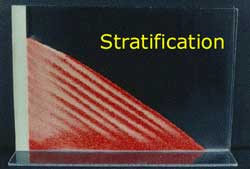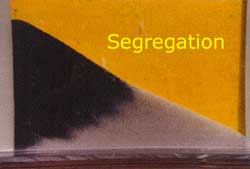
Fig 1a. Stratification (red sugar, glass beads), from Makse et al (Makse, 1998)
or,

Fig 1b. Segregation (black sand, glass beads), from Makse et al (Makse, 1998)
Makse et al (Makse, 1997) described how a granular mixture of two species in equal proportions poured between two closely-spaced plates (a vertical 'Hele-Shaw cell') can sort itself in the process of avalanching. They say when this sorting happens, it usually takes one of two forms, depending on the shapes and sizes of the grains:

Fig 1a. Stratification (red sugar, glass beads), from Makse et al (Makse, 1998)

Fig 1b. Segregation (black sand, glass beads), from Makse et al (Makse, 1998)
I thought I'd give it a try using sand I had on hand from a dune in southeastern Utah; this web page describes what I did and what I saw.
To reduce the amount of sand required, I built a sloping cell, as pictured to the right. Clear 3mm-thick Plexiglas was used for the front of the cell and for spacers that formed the bottom and right end of the cell (thus the cell was 3mm wide). The back was 2mm-thick white Plexiglas. The left end was left open so that sand could flow in at all heights from a paper hopper. To discharge static electricity (which can cause sand grains to cling to the Plexiglas, especially in dry air), the inside Plexiglas surfaces were covered with anti-static plastic lens cleaner (regular plastic-eyeglass cleaner); rather than wiping it off, it was spread evenly in a thin coating and left to dry. Clamps alone hold the pieces together, as shown in figure 2. The cell was clamped to a 2x3 of wood and mounted approximately at the angle of repose (the angle at which the sand rests after avalanching). A U-shaped length of masking tape was positioned sticky side up over the bottom spacer such that the bottom of the cell had exposed sticky tape (soon covered with sand grains); this avoided sand slipping down a bare, slippery Plexiglas surface.
All the plexiglas pieces were obtained at a local plastics shop (from their off-cuts bin, as it turns out).
The sand was mixed thoroughly prior to each trial. Sand was retrieved by unclamping the cell from the table (fig 2) and dumping it onto paper.
The flow rate is governed by the size of the hole at the bottom of the paper funnel feeding the paper hopper at the top of the cell. Sand could be dropped directly into the cell from the funnel but using a hopper provides a reservoir to produce high volumes for gated flows, and absorbs the kinetic energy of particles falling from the funnel (which otherwise might bounce down the slope).
The sand was from the Coyote Buttes area (Paw Hole), southeastern Utah, USA. It has a unimodal distribution of grains from 90 to 710 μm in diameter, with about half of the grains from 350 to 500 μm in diameter (photomicrographs of Paw Hole sand grains). Angle of repose in this cell for this sand was about 34 degrees.
The video below shows sand flowing, about mid-way down the slope. The hopper flow rate in this case resulted in cycles between accumulating at the top of the slope, then avalanching to the bottom, then backing up to the hopper. A velocity gradient within the flow is visible during the flow phases, and grains accumulate at the base of flows.
Fig 3. Video of avalanche cycle
The sand didn't stratify the whole length of the cell, but visible layering occurred in the upper portion of the cell, when the hopper flow rate was such that sand alternated between accumulating and avalanching (as seen in the video clip). When visible layering occurred, it was limited to roughly the top 20cm of the slope, fading out downslope. Click on the photo above (Figure 2) to see expanded views of the sand at the top and bottom of the chute. Strata near the top of the chute were about 2.5mm apart.
Layering only happened with certain feed rates (ones that accommodate a cycle of slope-building backups and then over-running flow, as opposed to continuous flow). It looks like finer grains settled out during avalanche flow while larger particles continue tumbling downhill, and after about 30cm, there are only larger particles left in the tumbling mix (and thus no obvious layers).
Much may depend on the distribution of grain sizes in the granular mixture, and proportions of the populations. The sand used here had a unimodal grain size distribution, and only a small fraction of the grains were fine (whereas the population used by Maske et al was bimodal with 50:50 fractions).
The cell above was only 3mm wide (I didn't have a lot of sand on hand); it's likely that the grains (which were in the order of 0.5mm in diameter) were stabilized by the walls and may behave differently on a more open slope.
Makse, H.A., Havlin, S., King, P.R., Stanley, H.E., 1997. Spontaneous stratification in granular mixtures. Nature 386, 379-381.
Makse, H.A., Ball, R.C., Stanley, H.E.,Warr, S., 1998. Dynamics of granular stratification. Physical Review E 58, 3357-3368.
In "Dry-Sand Tracks in Dinosaur-Triggered Grainflows", David Loope describes how Navajo dune faces captured the tracks of Jurassic dinosaurs.
Below is a video clip of a small peg-legged 'dinosaur' stepping on an 'avalanche slope'. It's interesting to see how the sand compresses and displaces to record the track, and then avalanches to bury the track. The imprint is nicely preserved under the surface. Amazing!
Video of a 'dino' stepping on dune
January 2005